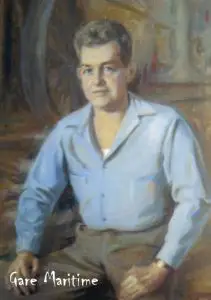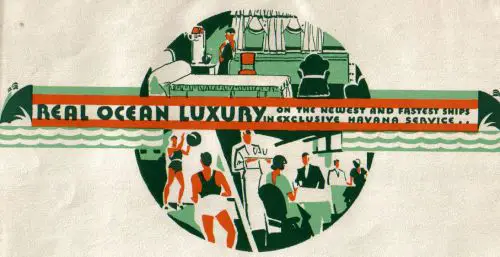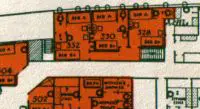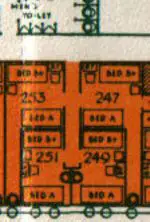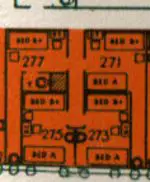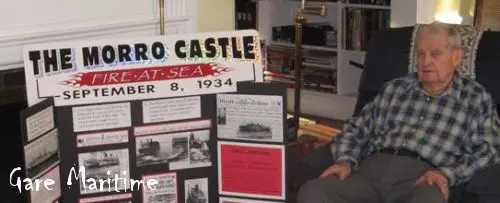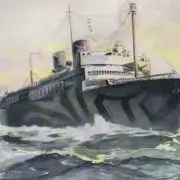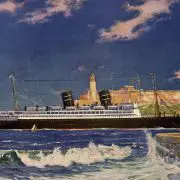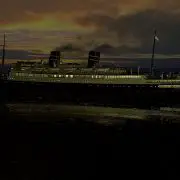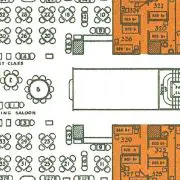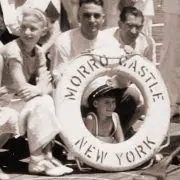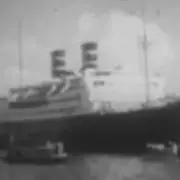George Watremez : Morro Castle Survivor
Memories of a Morro Castle Survivor
“I did go back to boats, and I’m not scared of the water even though I still don’t know how to swim.”
George Watremez, Morro Castle survivor, smiles slightly and continues; “To tell you the truth, I don’t think about it often….”
Mike and I are sitting in the living room of the Watremez residence. It is a large room, furnished with antiques that span the history of the 216 year old house. A pair of oil paintings, dating to 1961 hang on the wall over the couch, showing Mrs. Watremez looking coolly elegant with upswept hair and delicately crossed hands, and Mr. Watremez, in a portrait tiled “The Tool Maker” looking handsome and natural in a blue work shirt with an open collar. The room is sunny and friendly, and so too are our hosts. Mrs. Watremez sits beneath her portrait and the contrast is not cruel. She has expressive features, an easy smile and a gracious manner. Mr. Watremez sits to my right in a comfortable chair. Again, the contrast between The Tool Maker from 1961, and its subject “in the flesh “ in 2006 is not cruel. He recalls names, dates, and places from 1934 with almost startling accuracy. He can relate a story in a way that keeps your attention focused throughout, without exaggerating or resorting to ‘storyteller’ tactics. Like his wife, he is immediately likeable and from the moment we were seated both Mike and myself have felt completely at home.
George Watremez was 19 in 1934, and employed by Dr. James Coll of New Jersey . Dr. and Mrs. Coll were traveling to Havana with George’s cousin, Dr. Jules Blondeau and his wife, Margie, and in an act of generosity, Dr. Coll treated his chauffeur- George- to a cabin aboard the Morro Castle on what proved to be her fatal voyage. Jules and Margie Blondeau would swim six miles to shore on the morning of the fire, while Dr. Coll would be killed in a freak accident and his wife Dorothy brought back to New York City aboard the Monarch of Bermuda. George jumped from the C Deck fantail at the height of the fire, drifted in his life jacket for 8 hours, and was rescued by the Paramount. A self-described “packrat,” Mr. Watremez still has, in his possession, the 1934 deck plan and interior brochure he received before the voyage, a carefully preserved towel from a Spring Lake hotel that he was given with which to dry himself when he was brought ashore, and the pocket watch he carried with him through the disaster, monogrammed with his initials~ G.L.W. ~and engraved: Morro Castle: September 8th, 1934. “The one thing I regret that I didn’t keep,” he says, “is my life preserver.” It was removed from him aboard the Paramount and he did not retrieve it upon disembarking. A photocopy of a clipping from the family collection shows a distant view of Morro Castle survivors walking towards shore along a dock, among them George: someone has written “George” in the sky portion of the photo, and an arrow points downward to the small, but recognizable, face in the crowd. A box holds a huge stack of New York City newspapers covering all aspects of the disaster~ I randomly reach into the stack and extract a 1935 edition of the New York Daily News with a cover photo of the burned out hulk of the vessel being towed into Gravesend Bay in Brooklyn. I want, badly, to read through the entire pile, but knowing as I do vintage newspapers’ tendency to self-destruct into a pile of loose pages and paper fragments, I resist the urge to begin digging.
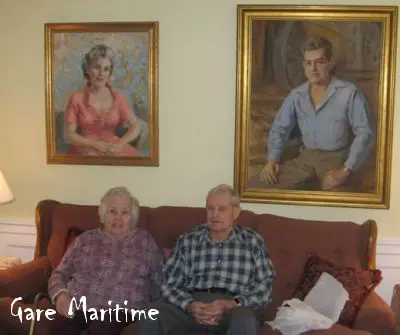
Jeanne and George Watremez, November 2006.
Married since 1941, Mr. and Mrs. Watremez, in person, possess a timeless charm and are immediately likeable. Photo courtesy Michael Poirier
Within a few minutes of commencing the conversation, Mike and I realize that, Morro Castle connections aside, Mr. and Mrs. Watremez, and their daughter Paulette who arranged this meeting, are very interesting people. Over the course of five hours, the discussion moves in directions I never imagined that it would. “The Normandie” says Mrs. Watremez, her facing lighting up, “she was the most beautiful ship. She was like a yacht.” Mr. Watremez’s family owned a popular French restaurant, La Tour Eiffel, on West 52nd street during the 1930’s and early 1940’s and members of the Normandie crew ate there. George and Jeanne Watremez visited the ship several times, and on a cold February afternoon in 1942 witnessed her burning. George recalls the frustration of the Normandie’s skeleton crew, billeted at the Hotel Chesterfield after the U.S. takeover of the liner in the latter half of 1941, at not being permitted to board the ship and aid with the efforts to save her. Later, after the war, Mr.and Mrs. Watremez and their children traveled aboard all of the major French Liners; Liberte; Ile de France; France. They sold the restaurant in 1948 ~ the new owner then resold it to Frank Sinatra and it became “Jilly’s,” the theater district restaurant run by his friend Jilly Rizzo. We have come to discuss the Morro Castle, but our hosts have proved to be an amazing source of unexaggerated and very precise anecdotes regarding classic ocean liners, World War 2, and Roosevelt-era New York City. The conversation touches upon all of my areas of interest in the field of history, and with each new tangent I grow more impressed- and wish that I was tape recording it all for posterity. The family is aware of the disasters to the Havana and Mohawk in the months following the Morro Castle , and are surprised to learn that a Mohawk survivor, Karl Osterhaut, lived out his life ‘just up the road’ from them in a neighboring town. They wonder, aloud, if he read the interview George gave to a local paper in the mid 1980s. They listen, and laugh, as Mike and I tell briefly of surviving the world’s first portable shipwreck ~ the Queen Mary 2 January 2004 Maiden Voyage.
George Watremez’s Morro Castle memories
Taped interview
Courtesy of George Watremez and Timothy James Raymond
It was 1934, when the United States was in the midst of the Great Depression and everything was just about at a standstill. Anyway, I had just been out of school – not too long – and I had obtained a driver’s license. And this licence allowed me to chauffeur cars and whatnot, and drive for hire. And I had a cousin who worked for a doctor~ this cousin was a medical technician, and of course jobs were hard to come by. If you worked in those days you were very fortunate. And through my cousin I was able to obtain a job driving for this doctor, and so I drove for him for quite a while. Come about mid August 1934, he decided that he and his wife would like to take a cruise, and invited my cousin and his wife to go along. And since I wouldn’t be doing anything for a week brought me along, too. The cruise was to Havana, Cuba, which in those days was the mecca of crusies and places to go. And everything was decided and the ship was the Morro Castle.
The tragic day Morro Castle caught fire
The Morro Castle was owned by the Atlantic Gulf and West Indies Steamship Company, that was better known as the Ward Line. Well the date of the departure was September 1st, 1934, and I was going to be gone for week. The fare was about $65 per person which was expensive in those days. The departure was beautiful, with streamers and confetti, it was really a gala event. On board the ship there was good entertainment- there was shuffleboard, there was skeet shooting, there was tricycle racing and all those deck games. The food was very good. We arrived in Havana and it was a curiosity to see this, as we’re pulling in to the pier there was any number of Cuban boys that were swimming along with the ship, next to the ship, and you’d throw coins to them and they’d dive for them. They’d pick them up and they’d show you the coin they retrieved. So, people were throwing nickels, dimes, quarters, fifty cent pieces. Pennies- they didn’t go for. Anyway, Cuba was a very beautiful spot. We had sightseeing tours~ we were driven around in touring cars. It was really a nice thing- the beaches were beautiful. Of course, there come the day of departure. We were only there a day and a half, and we left in late afternoon. And, here again there was sports and music and whatnot. And on the afternoon, evening of September 7th, which was supposed to be the gala evening of the whole trip, it was supposed to be the Captain’s Dinner with dancing and the orchestra- it was going to be ‘big doings.’ However on that afternoon, maybe 6 o’clock at night they announced that the Captain had died- that would be Captain Wilmott, the captain of the ship, and therefore there would be no entertainment that evening and it was up to the passengers to do as they pleased but there‘d be no ship‘s entertainment in respect to the Captain. Well, that was fine, we made our own little fun. Finally it was close to one o’clock, two o’clock in the morning and it was time to go to bed ~ we all did, because tomorrow morning at eight o’clock we’d be docking at Pier 11, East River in New York City. So we decided we’d get a little sleep before that. And I went down to my stateroom. Now all the way down I’d had the stateroom to myself but on the way back I had a room mate. And I went to bed, and he’d gone to bed.
Well, I was just about getting to bed and I heard the hammering and pounding of pots and pans in the hallways and whatnot, and they were screaming that there was a fire on the ship. Now, we had never had a fire drill- we’d never had a boat drill, and I went down by the porthole where the sink was and I looked out and the whole ocean was red. It was a terrible sight and I knew something was really wrong. I immediately put on my life preserver- it was an old fashioned cork arrangement, and I took off and my room mate gave his life preserver to a woman who was standing in the hall. So he was without one. I decided I’d do down and see if I could get my cousin and his wife out of bed. I met them halfway down the companionway. Now, we were on C Deck but the doctor and his wife were on D Deck, so I told them, I says “I’ll go down and get the doctor, make sure that he gets out.” So, I got down to D Deck and they were right there at the door just going around and trying to get into life preservers, and then the lights went out on the ship and the ship became completely dark. And I told them, hold hands and the three of us held and I said “I know the way out” so I led them out on to C Deck. When I got on to C Deck, and the place was all in a blaze. From C Deck we went up to B Deck and it was absolutely abominable what you saw- the flames were going sky high and the ship was just whirling. Of course, all this time the ship was in motion and we see a person, a crew member I guess, trying to use a hose and the hose goes dead and the water stops. B Deck had no cover on it, so it had plenty of light with all the flames, and on the deck itself there were shoes, and underwear, and pants and coats, hats, ladies handbags stern all over the deck- that’s just before the people jumped overboard. Well, we got separated and I went back down to C Deck. It was mobbed down there, and people were trying to jump- jump overboard but the ship still had vibration and I wouldn’t move while I could still feel vibration, Finally I felt the vibration of the ship had stopped, then I knew the engines had quit. You could see the steel of the ship was alive with fire and smoke and burning, but it wasn’t the steel that was burning it was the paint- the lead paint. I managed to get to the rail at the real stern of the ship, and I stood up on the rail- I was hanging on to the flagpole. And the last thing I said before I left- I says “if you don’t know how to swim it’s a damned good time to learn.” There was a mess of ropes and hawsers that were dragging along with the ship that people had thrown over so that you could slide down if you wanted to, but that didn’t work too well. The thing was, which we didn’t realize at the time. Most of the crew had already abandoned ship and took off in what lifeboats there were so there wasn’t too much that the passengers could do but jump. I jumped off from the stern and I had the presence of mind to hold my life belt close to me with my arms real tight against me and my two feet together. I had lost one shoe in the deal but I had one on when I hit the water. Now when I left the ship and until I hit the water seemed like an eternity. But it was much longer, I thought, as I kept going down in the water until finally I slowly came to a stop and I thought I was on the bottom but, of course, I wasn’t.. And then I started up and gained speed as I came up and finally I got caught in all these ropes dragging along behind the ship. So I was lucky enough to break loose and there I saw ~ real spectacular- this great big, huge ship a complete blaze and just drifting away in the dark. It was really a nightmare to see. And lot of the people they didn’t make it, they were killed because when they jumped they kept their arms spread apart and that big heavy life preserver would slam up and break their arms or hit them under the chin and they were a goner. These are not the same life preservers you have today.
Surviving Against All Odds
The people were in the water all around and it was just a crowd in the water. Finally, they started forming groups, well, I stayed close to a group but I did not join because I was afraid I’d be pulled down by someone who was drowning. I wasn’t in the water too long when my room mate ran across me and he still did not have a life preserver on. He kind of hung on to me until a little while later we came across a little boy who might have been eleven to twelve years old- a tiny fella- and he was in a full adult life preserver but it hadn’t bee tied on properly and he kept sliding out, and he was fighting to stay in it. We managed to tie him in properly and then the room mate stayed between the two of us, still no life preserver. As time went on and the room mate was really starting to wear down we decided he needed a life preserver. But, where to get one? He was very reluctant ‘cause we’d take it off a dead body. But finally we convinced him it was the only thing to do and we approached a dead body and took the life preserver off it and he put it on, and then the three of us stood a better chance. Now, a s I said the storm was racing and the waves were running maybe 15, 20 feet high if not more, and they were very sharp. You’d be forced to take a drink of water which was bad. You’d get seasick- very seasick. When it stopped raining and the wind went down, it seemed to be that the waves, instead of being in peaks and sharp, it seemed to be that they were rollers but still 15 feet high, and that’s where we started realizing that we were drifting in to shore. It was daylight and we could see people on the shore. They looked like tiny little specks, at this time we were probably a mile offshore. At this time the room mate and the kid decided to make and swim for it- decided to swim to shore, and they wanted me to go with them. I said that I didn’t know how to swim and I’d only hold them back, so I said ‘you guys go ahead, forget about me.’ As I said, there were people here there and everywhere in the water but not as crowded as before because we were dispersed. So, they took off and I never heard…but I know they made it, I found that out much later. As luck would have it, the tide changed and I started drifting out again and pretty soon the people on the shore had almost disappeared and we couldn’t see anything. We were just drifting out with the tide. Time gone by, and finally a fishing boat- a party boat- she was the Paramount, she was owned by a fellow named Bogan. The other two ships that were there at the rescue were the Monarch of Bermuda and the Andrea Luchenbach. Finally the Paramount showed up and picked up a person over here, and then picked up a person over there, and then picked up a person very near me, and I heard the motor start up again and I yelled out “What about me?” and Bogan yelled out “You’re alright, we’re coming!” and I yelled out “I don’t know how to swim” and he yelled back “Then what the hell are you doing out here?” There was always some humor, I guess.
So, sure enough they come and they picked me up, and I managed to get on board. I’m not sure, but I may have been the last one, or the next to last one to be picked up. When I got up on deck he said “At least you helped yourself” and I said “yes.” and I landed on a pile of human flesh. I mean, people just in a heap, out, unconscious, nobody was moving. Some in nightgowns and whatnot, I‘m telling you, it was a real…real…there’s no explanation, it was really a total mess of people on that boat. Now, Bogan himself had his mouth all bloodied because he slipped and hit his moth on the rail of the ship picking up somebody and broke his two front teeth and cut his lip. I passed out. When I got up, we were starting to get close to Spring Lake, they handed me a bottle and it was a whiskey bottle but I thought it was water. And finally they took it away from me and told me ‘This is all we have on board.” Actually I’d been in the water eight and a half hours, having gone overboard at about a quarter past three and picked up around noon time. So, it was quite an ordeal.
By the time we made the boat landing at Spring Lake, most of the people were starting to come to, starting to get themselves together. We got off and walked down a companionway to what I’d call a boat house, and here there was all kinds of newspaper reporters and newsreel cameramen, and really it was something else. They had made provisions for us to be taken care of to a certain extent- that is the authorities, the Fire Department, the Police Department. The red Cross got in on it, and so did the American Legion. It was really well done to help us out. I was handed a towel, and the Red Cross also handed me a pair of bib overalls and a blue shirt. I was able to take my clothes off, dry myself, and put these dry clothes on. I didn’t have any shoes, but that was alright. I didn’t get my clothes back for about a week or two, and they were mailed to me from Spring Lake. I as interviewed by Universal newsreels but I don’t know if I ever showed up- I never saw it in any of the newsreels. Finally we walked up to the road a bit to a railroad siding, and here they had a special train for us, a steam locomotive with two cars. When I got there it was difficult for me to walk because of the cinders along the tracks. So, this one fella came up to me and he had an American Legion cap on. He says “What size shoe do you wear?” and I told him, and by god within ten minutes I had a brand new pair of shoes upon my feet. Finally I got on the train and we start heading for Penn Station in New York City. At one interval we changed to an electric engine so that we could get into Penn Station. When we did get in, everything was roped off. And again, there was newspaper reporters, police, cameramen, what have you. We never did get outside because the platform we were on was roped off, and we had a path roped all the way through the terminal. We were escorted underground to an elevator that took us to the Hotel New Yorker, that was at 34th Street and Eight Avenue. I forgot to mention that while I was in Spring Lake being taken care of, I had the opportunity to send a telegram home to tell the folks I was okay. That worked out pretty good. Now, going back a bit, when I was in the water the newspapers came out with this story about the Morro Castle being on fire, and hundreds of people dead, and the New York Journal had me as “Missing.” Now, there was my stepfather’s brother. He had picked up the newspaper and saw the whole article, and he took and hotfooted over to the restaurant and told my stepfather about it. My mother was working down around Union Square, in clothing- she was a weaver, a mender. So he called up and told them not to let her see a newspaper but as the story went on they started yakking amongst each other, and she caught on that something was wrong. So I guess my telegram took care of her a little in that way. We were walking as a group, and, believe me, we were quite a show to see, all kinds of clothing, blankets, what have you. My stepfather’s brother who was down there in the subway station. I guess he knew, he’d heard where we were coming in and he crawled under the ropes and he came along with me and it was quite a happy reunion. I must say that my mother and stepfather were at the Hotel New Yorker when I arrived, and believe me it was quite a reunion, and very sentimental.
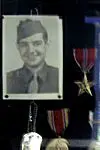 Of course, after spending so many hours in the water with a lifebelt rubbing up and down and also my pants leg rubbing along my legs, I was chafed to no end. My skin was completely raw. Chest, legs, crotch, whatnot, it was real nasty. So, I was smeared with salve. The next morning, after that, I was pretty well dried out, it was difficult, very painful.
Of course, after spending so many hours in the water with a lifebelt rubbing up and down and also my pants leg rubbing along my legs, I was chafed to no end. My skin was completely raw. Chest, legs, crotch, whatnot, it was real nasty. So, I was smeared with salve. The next morning, after that, I was pretty well dried out, it was difficult, very painful.
My cousin and his wife, they swam to shore, they made it all the way to shore. They were exhausted, and they spent a couple of days in the hospital. The doctor and his wife~ she was rescued by a launch of the Monarch of Bermuda. It was a power launch and she was taken out of the water. She heard them yelling, a crew member yelling “Look out for the propeller” and I guess the propeller hit her husband over the head, split him right open and killed him instantly. They did not pick him up then, they let him go, and we identified him and, of course, had the services for him later on.
The Aftermath: Life After the Morro Castle Tragedy
A few weeks later, after my being home for a while, I got a subpoena to the United States District Court, Southern District of New York, to be a witness in regards to the Morro Castle. I did show up several times, but I wasn’t actually called to the stand- I was just as happy. One thing that is not commonly known is that the Ward line lost three ships in five months, with the first being the Morro Castle, the second being the Havana and the third being the Mohawk.
I hope that in making this tape I’ve served a purpose and that whoever hears it will be happy with the results. From time to time I can remember a few things that are not in this tape, however, I enjoyed doing it and I hope it serves a purpose. Take care!
George Watremez, November 2006.
Mr. Watremez is posed with a display board created by a grandson for an award-winning school project.
Photo courtesy Michael Poirier.
Jim Kalafus continues…
It is close to 5AM on Saturday, September 2, 2006. 6 days short of the Morro Castle anniversary and I am standing on the stern of the MV Zenith as we pass over the general location where the disaster unfolded. It is a private ritual I try to observe on northbound voyages~ a quiet time to think, in depth, about this interest of mine. In only an hour we will be approaching New York Harbor, and I ponder how close to home and safety the 500 people on board that night were, when everything suddenly fell apart. Tropical storm Eduardo is following us up the coast, exactly as happened on September 8, 1934. The sea is rough, with both rolling and peaking waves, and although the sky is lightening with the coming of dawn, it is still a leaden gray. Rain drives down and wind lashes against the starboard side of the ship and, from where I am standing, the view is remarkably similar to that seen by those who stayed with the Morro Castle for as long as possible. I can occasionally see lights through the murk along the Jersey Shore, but they look impossibly far away. Below me, the ocean crashes and bubbles and rolls and from where I stand-about as high up as the Morro Castle’s B Deck fantail – it looks like a long drop to the water. An NCL liner, brightly lit, is off our port side, about as close as the Monarch of Bermuda was that morning. Close, until one considers what it would be like to jump into the water below us and wait for a boat from her to come along. I am having the opportunity to fix, in my mind, a living picture of what it was like but, of course, it is not the same at all. Thick clouds of smoke are not rolling aft at me, and there is no one behind me pushing and jostling to get to the rail before collapsing and suffocating. The ocean looks intimidating, but I am not minutes away from one form of death and being forced to jump and confront another. I look at the view of waves and gray sky and think of what it must have been like to be falling, and momentarily free of the gagging smoke, as one’s view became a kaleidescope of gray sky and gray water. For many it was the last second~ then, a brief struggle, blackness, and nothing. Others would rise to the surface and be quickly carried away by the waves and the tide, fanning out into the stormy distance as the sky continued to lighten Some would swim or drift all the way to shore, and three out of four of those who jumped would survive. But, for at least 130, what I am looking at more or less represented The End. 40 would never be found, and close to 20, unidentifiable in 1934, now rest in a burial plot behind the former Fitken Memorial Hospital. I toss a private remembrance from the stern, as I always do at this spot, and step away from the sad thoughts of 1934. My clothing soaked through in places, I return to the cabin, where Tim is doing some last minute packing. In a little over an hour we’ll be safely passing under the Verrazano Narrows Bridge and returning to the real world.
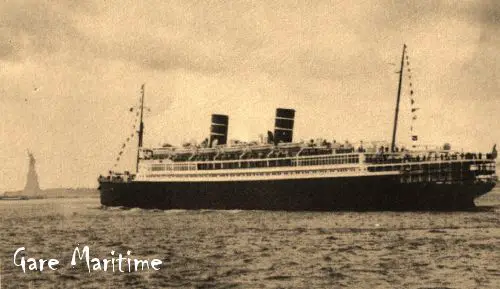 Postscript: 13th December 2006. One of the Morro Castle loose ends that has been bothering me for quite a while was tied up today by George Watremez and Paulette Cole. Other than in the newspapers and Ward Line memos, I have never been able to find a trace of Dr. Jules Blondeau before, or after, the disaster. It turns out that literally every reference since 1934 has been incorrect. Their last name was Blondiau. A quick trip to SSDI showed that Jules Blondiau, who was born 1910, died in 1990, and that Margie’s first name was most likely Martha, and she was born in 1912 died in 1982
Postscript: 13th December 2006. One of the Morro Castle loose ends that has been bothering me for quite a while was tied up today by George Watremez and Paulette Cole. Other than in the newspapers and Ward Line memos, I have never been able to find a trace of Dr. Jules Blondeau before, or after, the disaster. It turns out that literally every reference since 1934 has been incorrect. Their last name was Blondiau. A quick trip to SSDI showed that Jules Blondiau, who was born 1910, died in 1990, and that Margie’s first name was most likely Martha, and she was born in 1912 died in 1982

